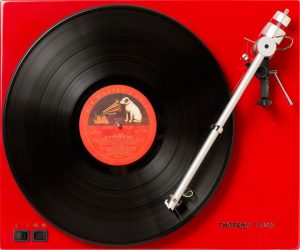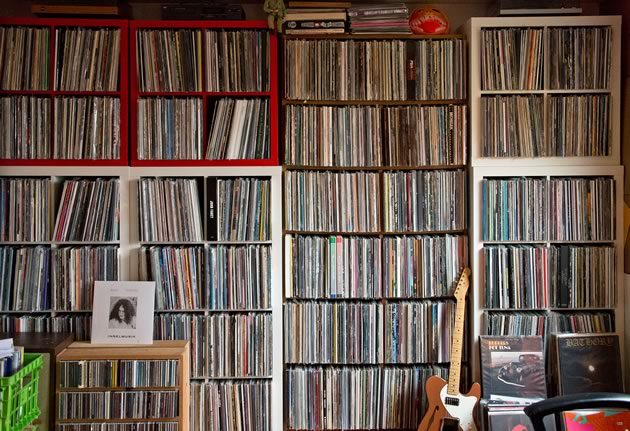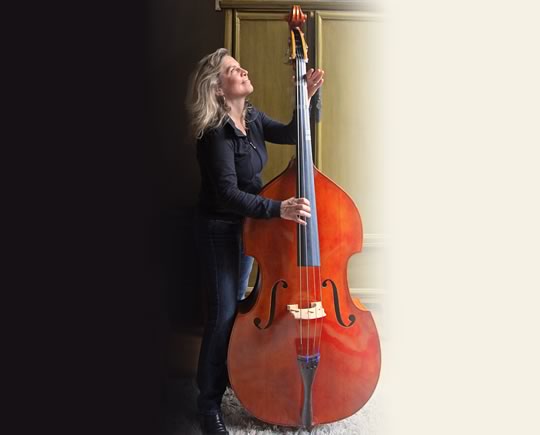The Vinyl Revolution
What Goes Around Comes Around
Music has never been more accessible. Online streaming services like iHeartRadio and Jango will play a list of whatever strikes your mood. You can pretty much find a tune from any time and place in the history of music on YouTube. Who buys CDs anymore? Just download an MP3 file.
So why the resurgence of old-school vinyl records?
Well, for one thing, they have more substance. They put the music you love not just into your head, but into your hands. And they add a visual dimension – often in the form of fabulous cover art. The Velvet Underground and Nico, for example, famously featured an Andy Warhol banana on their debut album cover. And I have often pored over the dense imagery on The Beatles’ Sgt. Pepper’s Lonely Hearts Club Band. The extended liner notes on the back cover and inner sleeve were an added benefit. I know from the notes on my Messiah album, for instance, that when Handel finished the “Hallelujah Chorus” he declared he had “seen the face of God.”
The very physicality of vinyl records also affects how we listen. Rather than hopping compulsively from tune to tune, artist to artist, there is a gratifying ritual to putting a record on the turntable and listening to a body of work from start to finish in the order the musicians meant it to be heard.
I was in a folk trio in high school that styled itself after The Kingston Trio and we listened to their albums over and over. (In fact, the first LP I ever bought was The Kingston Trio. I nearly wore it out.) Most Sundays the three of us would go out for a drive in one of our parents’ cars and we’d practise. Sometimes when we finished one song, we’d break into the next track on the album in perfect harmony. We didn’t plan it. We had listened to the records so many times we not only knew which song followed, but exactly how long the needle took to get from one cut to the next and what notes to start on.
The comeback of vinyl isn’t all about nostalgia, but it certainly plays a big role in its renewed popularity. This fall about 90 people showed up for an evening at the Orangeville Town Hall Opera House. The program, called “The Summer of Love,” took the audience back to 1967. For the better part of two hours, the focus of all attention was simply a record revolving on a turntable, an amp and pre-amps with glowing vacuum tubes, and the rich, roomy sound from the speakers. It wasn’t long before feet were tapping and heads nodding to songs such as “San Francisco” (“Be sure to wear some flowers in your hair”) by The Mamas and the Papas, and “White Rabbit” by Jefferson Airplane. In the second half of the show, “The Fish Cheer” (“And it’s one, two, three, what are we fighting for?”) by Country Joe and the Fish recalled the time when music was the focus of protest against the war in Vietnam.
“The music mattered,” said host Peter Wolter, “and as a witness to the ’60s and ’70s, it helped shape our lives, our outlook and our culture.”
The evening was a promotional event for Peter’s new Orangeville store Being There. “The boutique is the realization of a lifelong affair with all things audio,” he said, “that started with a Sony 8 transistor radio that I strapped to my bike’s handlebar as I delivered the morning paper.” Today record companies are cashing in on that kind of nostalgia, remastering and reissuing LPs that were popular back when.
But for audiophiles there is much more to the popularity of vinyl than just memories. The real magic? It sounds better.

NOT YOUR OLD HI-FI Tube amplifiers, once hidden away, are exposed to add a trendy industrial aesthetic to contemporary sound systems. Photo by Pete Paterson.
Trying not to get too technical, Peter later explained to me that while there are exceptional digital recordings, MP3 files cannot offer good quality sound. “Because it has to download in split seconds, the MP3 is a relatively small file. To make it smaller, the high and low frequencies have been chopped off and the rest have been compressed. Then to compensate they boost the volume so it plays back loud.” The result, he said, when you really listen, is thin and colourless. “Once you’re aware of it, the sound can give you a headache.”
The LP usually has a greater range of frequencies from top to bottom, so the sound is rich and full – at its best when reproduced through a tube amplifier rather than transistors. Transistors, Peter said, make the highs sound brittle, metallic and etched, but tube systems sound sweet and warm. And it’s on these he focuses his attention.
Peter’s cozy store is crowded with trendy industrial-looking tube amplifiers, graceful speaker boxes that look straight out of a Danish furniture catalogue, and turntables with delicate-looking arms. Some brands have lasted since the heyday of vinyl – Thorens turntables, for instance, and Spendor speakers – along with new brands, including some that are Canadian made. Finalé Audio amplifiers and speakers like the sleek Vivace Mini are manufactured in Scarborough and have received critical acclaim from audiophiles.
This new, fine-tuned equipment does sound better than older hi-fi systems. The timing, for instance, is improved. Peter explained that if the signals for the left and right channels don’t arrive at the speaker at precisely the same moment, the reproduction can be muddy. Another improvement is ambient noise reduction. The new systems are much quieter.
“What you’re looking for is an audio system to get out of the way,” Peter said. “Something that won’t limit the sound or add any noise of its own. You just want to hear what was recorded, all of it and nothing more.”

Turntables have become sleekly minimalist. But it’s not just about beauty, the new systems offer even better sound than their predecessors. Photo by Pete Paterson.
Some of the new equipment is expensive. “Audiophiles can spend as much as $15,000 just to buy a cartridge for their turntable,” he said. “But there’s a misconception that you have to spend a lot of money. You don’t. For $1,000 or $1,500 you can get a really nice sound. Later you can add to it or change things to make the sound even better.”
Peter is definitely onto something with his new venture. The surging interest in records is accompanied by the increasing sales in equipment to play them. Stereophile.com reports sales of turntables in the U.S. skyrocketed from 61,000 in 2014 to 1.4 million in 2015, and had already exceeded 1.6 million by August this year.
Surprisingly, it’s not only baby boomers who are interested in this new trend. Last Christmas, my son Mike asked for a turntable. Now he and his brother Steve both have them and are among the new generation who frequent record stores. They both have some earlier albums, but are more interested in records produced by today’s independent artists. In fact, all the collectors I spoke to have eclectic tastes.
Doug Byers, who lives near Mono Centre, is one of those. He started collecting vinyl 15 years ago. “I’d go to a lot of garage sales where I could pick up records for a dollar. Now I have about two thousand LPs for sale and about a thousand in my own collection.” Doug’s hi-fi system includes a tube amplifier, but he doesn’t turn it on as much as he’d like. “I’m always finding new and different recordings,” he said, “but now I have too many records and not enough time to listen.”
Nick Shinn of Orangeville, on the other hand, is always listening. “A lot of people have the stereo set up in the basement. Mine is in the living room and it’s always on.” Nick also frequents thrift stores, looking for ephemera as well as vinyl. As a graphic designer, he is as interested in the packaging as he is in the sound. “I’m more of an antiquarian, so I look at books and magazines too,” he said.
Another Orangeville collector, Mike Greenwood, hasn’t counted his records recently, but his collection takes up 60 feet of shelf space. Mike also collects musical instruments, movie posters, and information about them. I asked if his aluminum-neck guitar was a Kramer. “No. Kramer was one of the three partners that started making them back in 1976 …” He knows the whole story.

Although his vast music collection could probably now fit on a couple of good-sized USB drives, Mike Greenwood happily dedicates 60 feet of shelf space to his vinyl records. Photo by Pete Paterson.
In addition to the thrift stores, Aardvark Music & Culture on Broadway in Orangeville has a broad selection of LPs in several bins that occupy the centre of the store. Storeowner Perry Joseph says, “All kinds of people, different ages, different interests, come into the store to check out the records.” The collection is a combination of new recordings and remixes, as well as used LPs that started with Perry’s own. “I’d been collecting since the ’70s,” he said, “but when I moved five times in seven years, I had to pack and lift a thousand records. After my last move 950 of the records ended up in the store.”
Most of the music currently available on vinyl is those original recordings made decades ago, but contemporary musicians are also joining the movement. Perry, who is also a musician, singer and composer, made a vinyl recording with The Houseplants a few years ago. “The mixes were highly crafted,” he said. “When we heard the finished product, it made me cry. That’s how much better vinyl can be.”
Mono-based singer/songwriter Lisa Lobsinger is also a fan of vinyl. Perhaps best known for her work with Broken Social Scene, she now sings, composes and plays in a new group, Laser. This year, the group skipped the CD version in favour of releasing their debut album Night Driver on vinyl only (see review in “The Year in Music: 2016” ).
When I spoke with Lisa, an Andy Williams record was playing in the background. “No, it wasn’t my parents’,” she said. “I bought it. I grew up with a record player and worked in music stores in the days of CDs. Vinyl just sounds better. It’s like being hugged by the music. The sound is so much warmer and you can hear so many more layers.”
That vote of confidence from a generation who were toddlers at best when many of the songs they’re listening to were first recorded is a good sign vinyl’s resurgence is more than a passing fad, the last gasp of hoary baby boomers.
Still, for those of us who lived the era, it’s fun to look back. When I was thinking about the first album I bought on my own, I remembered the first recording I was given. Uncle Byng gave it to me, sort of. I was listening to the Small Types Club on the radio when host Byng Whitteker said, “Tony Reynolds should look for his birthday present in the record player.” Wow. I lifted the lid and there it was, Peter and the Wolf, music by Prokofiev, narration by Wilfred Pickles. Sadly I no longer have that record, but yes, you can download it. I checked.
Related Stories

Double Bass Dreams
Jun 17, 2013 | | Back IssuesThere’s nothing more exciting than the chemistry of getting in a room and playing with people.

The Year in Music: 2017
Nov 22, 2017 | | ArtsOur annual review of new recordings by local musicians.








